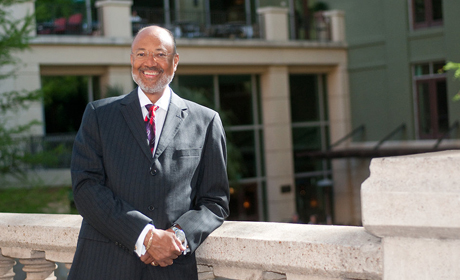Alumnus Milton Lee, chief executive officer of CPS Energy, San Antonio, tells how municipal utilities diversify to achieve sustainability and affordability.

Q: What fuels do municipal utilities currently use to generate electricity?
A: Only about 15 of some 75 municipal utilities in Texas actually generate electricity. We use a diversified portfolio to generate power: natural gas, western coal, Texas lignite, and nuclear. We’re all involved in wind projects, mainly purchasing power from private entities that can take advantage of investment and production tax credits. We’re also in small solar projects and landfill gas recovery.
Q: Which fuels are most efficient and less harmful to the environment, especially air and water quality?
A: I think the mix I just described. You need diversification from an environmental perspective and for affordability for your customers. You balance nuclear, natural gas, wind and solar, and include state-of-the-art efficiency and conservation programs to cut use. You give incentives for energy efficient homes. You add solar panels, wind and fuel cell generation on residential and commercial properties, then rely on your local utility for the rest of your needs.
Q: What are the barriers to this happening?
A: A lot of customers can’t afford fuel cells, solar, and wind. They may be able to afford more efficiency in the home. So if you take affordability into account, you move gradually off of fossil fuels and toward generating electricity at businesses and homes. Then municipal utilities become a controller of the system, with efficient technology so users can provide distributed sources of energy. You go from centralized generation at a big power plant to decentralized, small plants throughout your service area. This represents a 50 to 75 year goal, but it’s realistic. That would be a true transformation of our industry.
Q: Meanwhile, how do energy companies protect the environment?
One key is making sure that you get the full, useful life out of your facilities. Another is minimizing emissions levels at power plants through controls on stacks. It is very costly, but we can’t put our cities into non-attainment, or beyond federal limits on emissions.
We have to get power plants using fossil fuels as clean as possible, and go to cleaner fuels, such as nuclear, weaning off of coal and natural gas, which create the emissions.
I see utilities slowly moving toward smaller projects, using a little wind, a little solar. Municipal entities will move sooner than private generators, but as prices for solar and wind come down, we’ll see more of those renewables in the mix.
Q: What role do engineers play?
A: Without good, innovative engineers, this transformation isn’t going to get done. Engineers solve problems. We need them to provide technology to integrate all these systems and keep the lights on. Engineers will play a critical role in transforming from big central stations to smaller ones. But we have a tough time recruiting innovative and creative engineers. It’s a dull, boring industry and the creative minds don’t necessarily want to join it. It’s going to take all of us pulling together to get this done.
Milton B. Lee earned his bachelor’s degree in mechanical engineering in 1971 from The University of Texas at Austin. He has served San Antonio as CPS Energy’s chief executive officer since February 2002. He joined CPS Energy in 2000 after serving as CEO and general manager of Austin Energy during the 1990s. He began his career with General Electric Co., where he oversaw nuclear steam supply systems, nuclear fuel, gas turbine generators and steam turbine generators.
Lee has held a number of prominent positions in the electric utility industry. He has served as a member of the ERCOT Board of Directors and Technical Advisory Committee, and has held leadership positions in the Texas Public Power and American Public Power Associations. Lee is a member of the Cockrell School Engineering Advisory Board.







